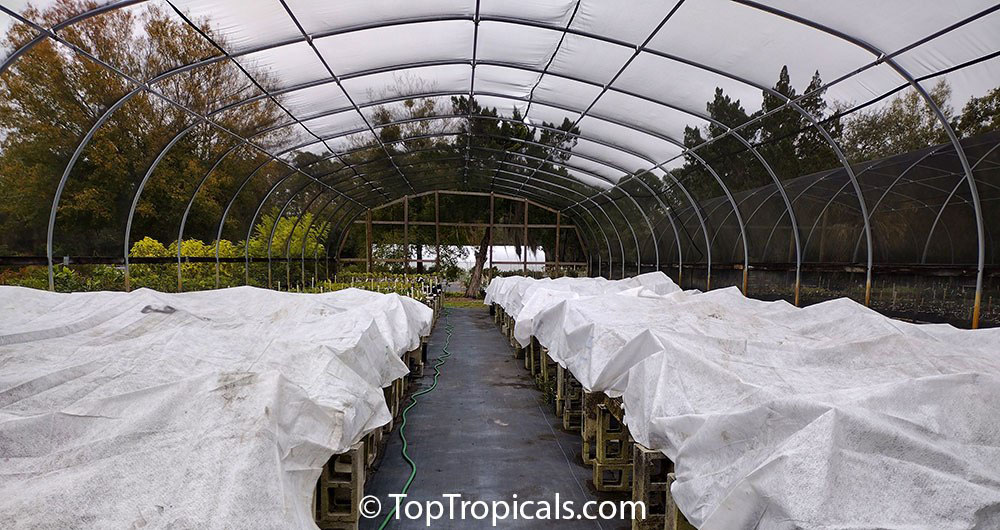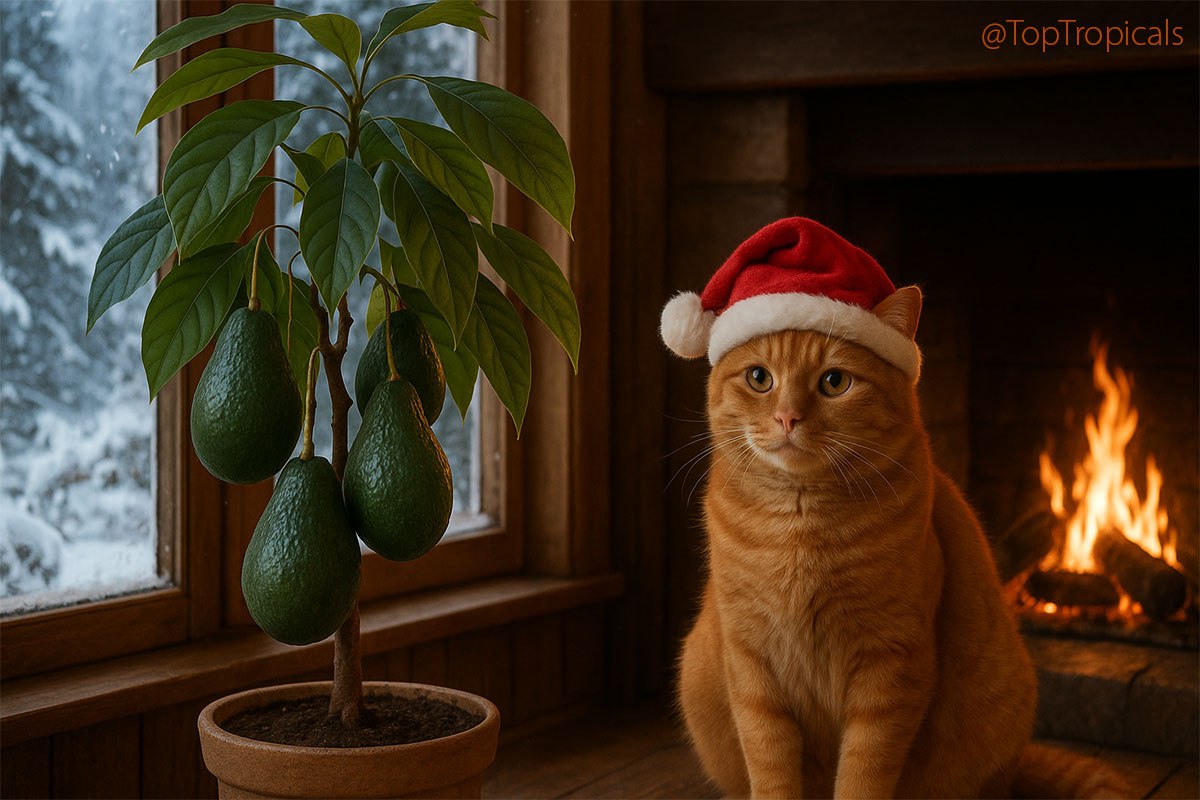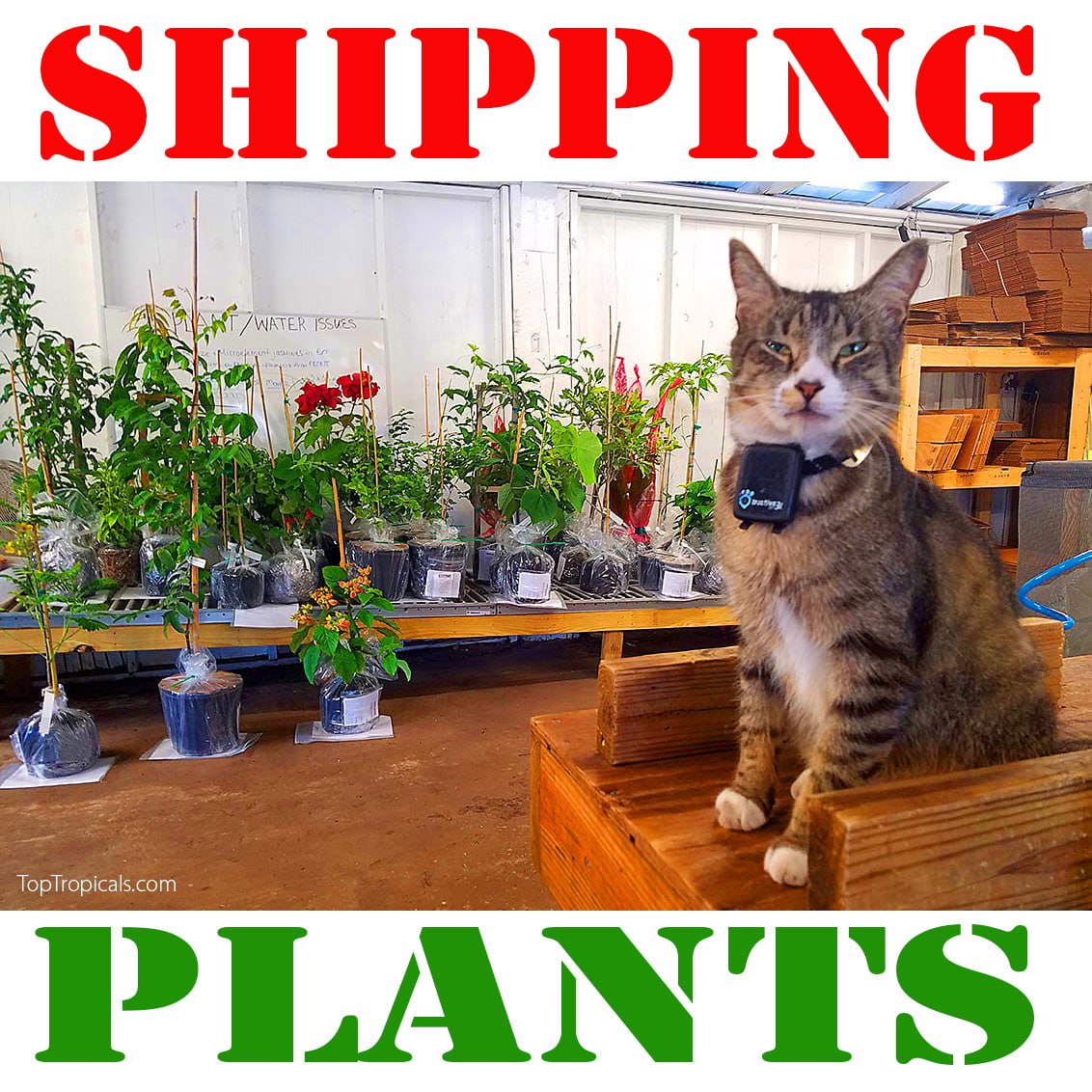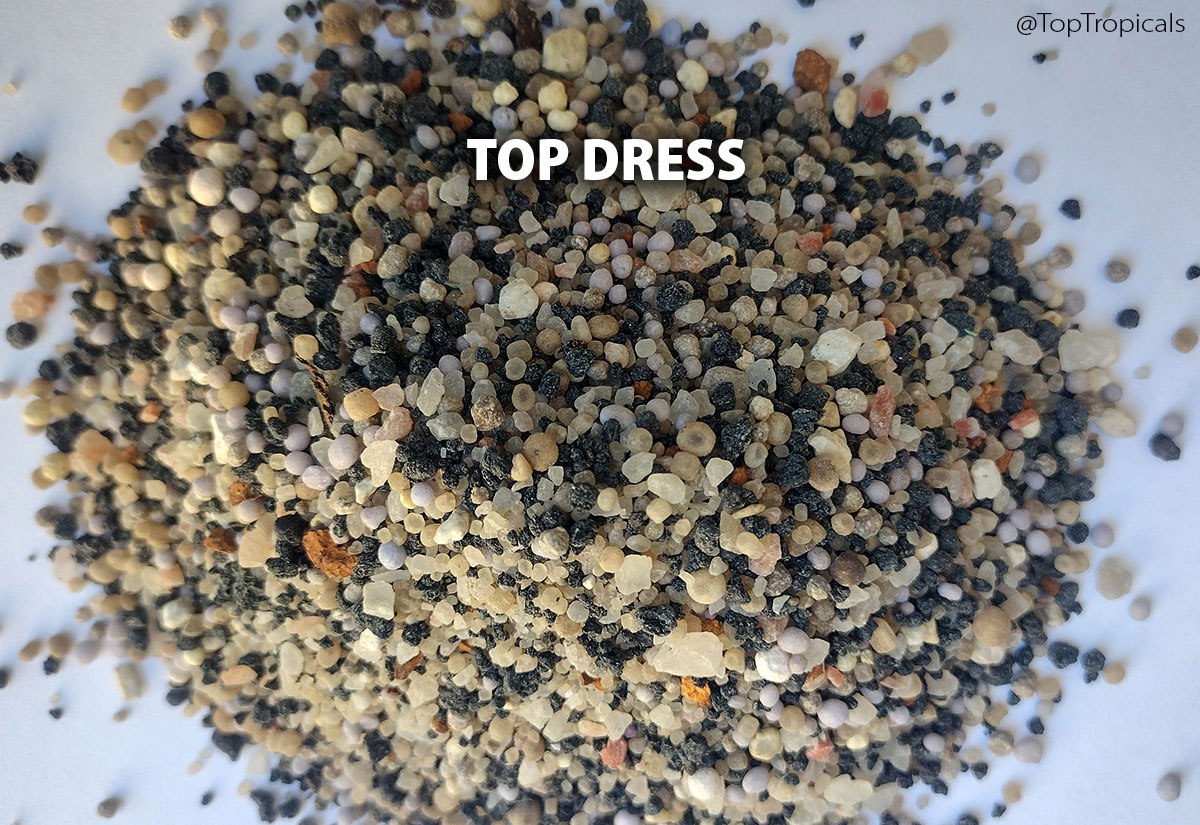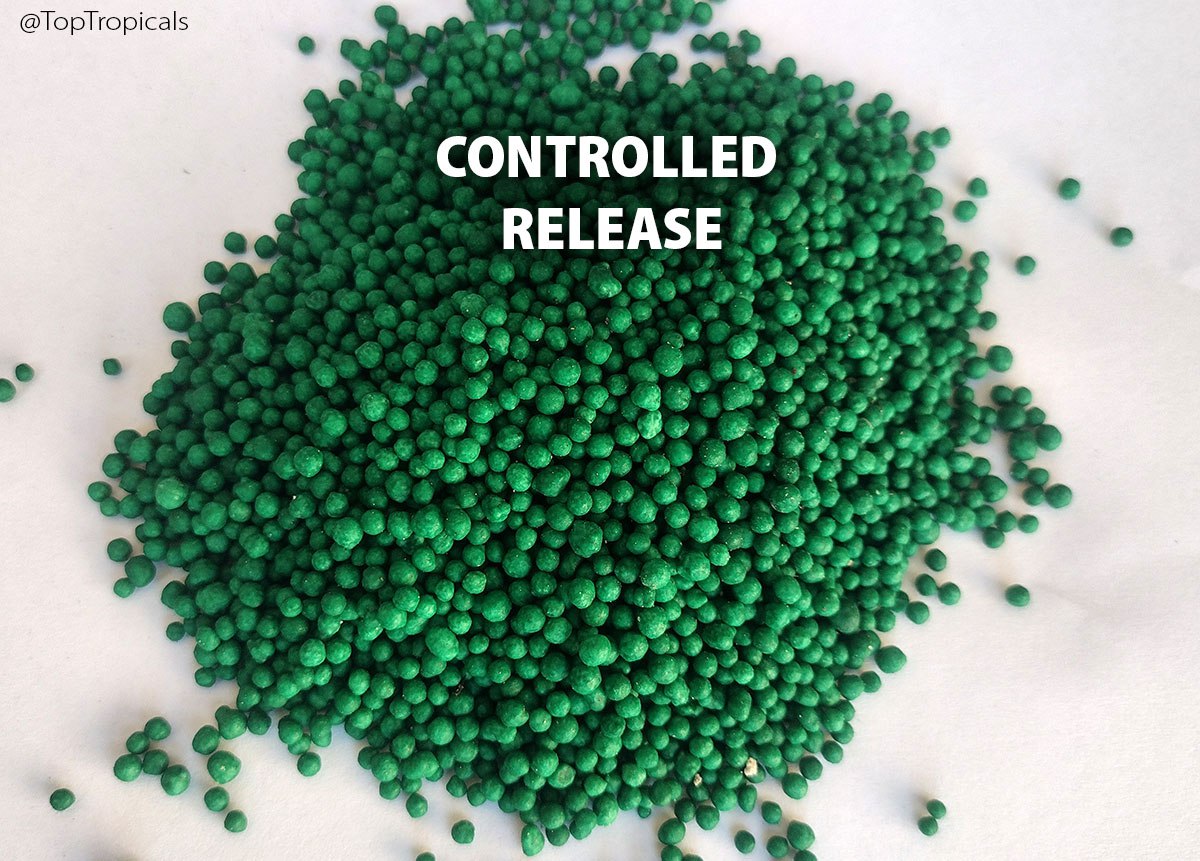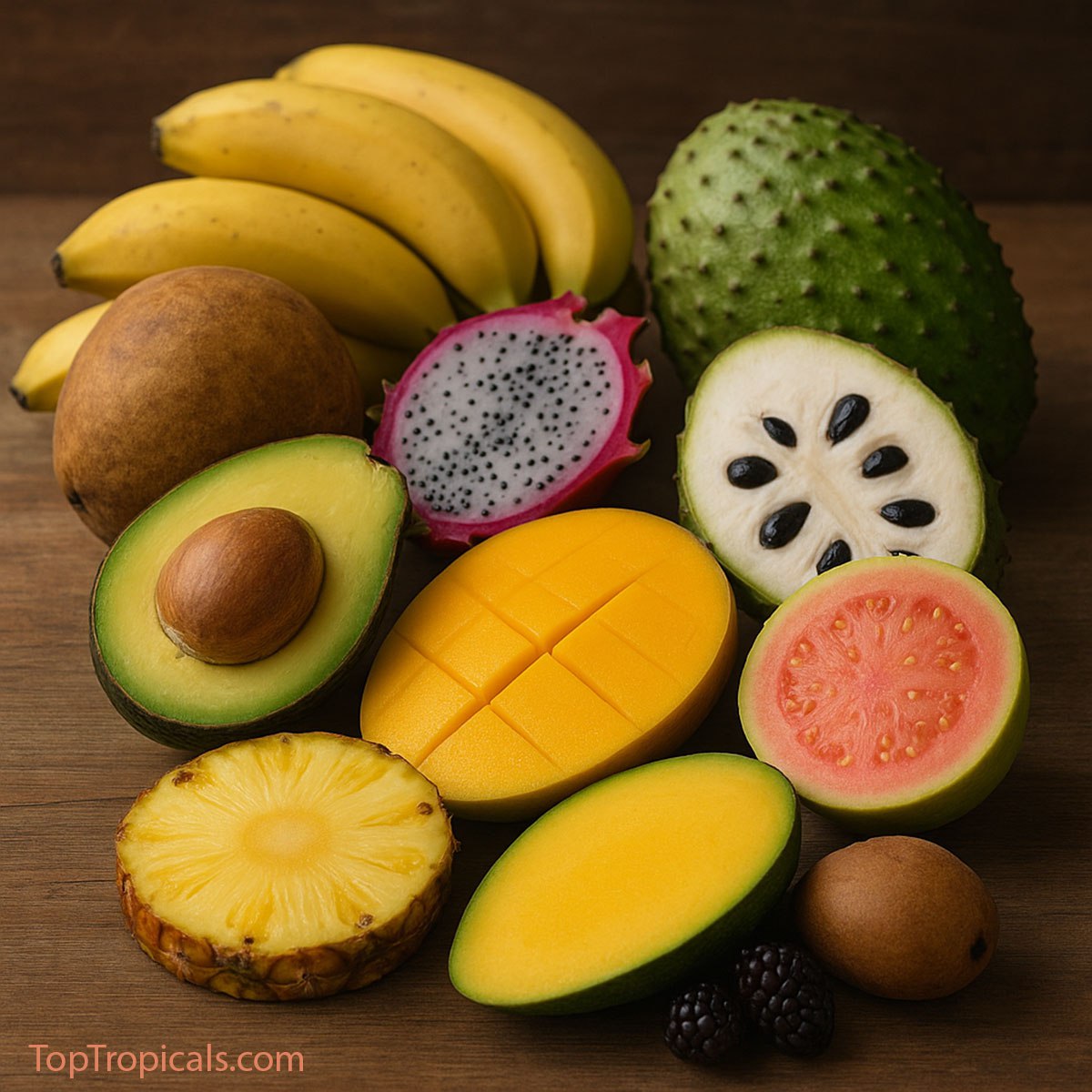Garden Blog - Top Tropicals
How to overwinter the tropical Bird of Paradise

Strelitzia reginae - the Bird of Paradise, bug plant
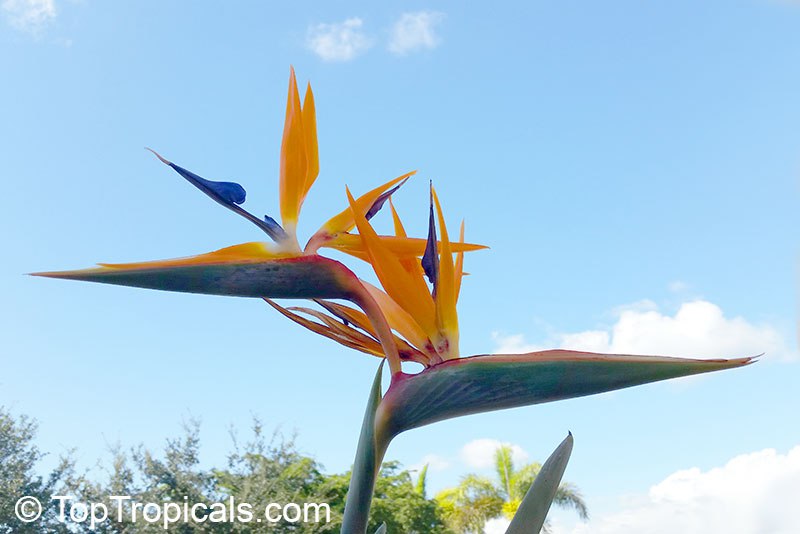
Strelitzia reginae - the Bird of Paradise, flower
❄️ How to overwinter the tropical Bird of Paradise
When frost threatens, water the soil thoroughly a day before - moist soil retains heat better than dry. Cover the plant overnight with frost cloth or breathable fabric, not plastic, to trap ground warmth. For large clumps, wrap the base with mulch or straw to protect rhizomes. After cold events, remove damaged leaves but wait until spring to cut deeply, as live tissue below may still recover.
📚 Learn more:
How to grow Bird of Paradise
🛒 Plant Bird of Paradise
#How_to #Container_Garden
🟢 Join 👉 TopTropicals
- Strelitzia reginae - the Bird of Paradise is a resilient tropical that can adapt to indoor conditions through winter if given bright light, moderate warmth, and careful watering. With a few preventive steps and timely protection, plants will stay healthy and reward you with vigorous new growth and blooms when warmth returns.
- When should you move plants indoors?
- What is the right location for a Bird of Paradise in winter, and why?
- Do you need to do anything before moving them indoors?
- Do plants need watering or feeding during winter?
- Can you overwinter Birds of Paradise outdoors?
- What tips do you have for protecting plants outdoors?
Move Bird of Paradise indoors before nighttime temperatures consistently drop below 55F. Extended exposure to cooler air can slow growth and stress the plant. In central and south Florida, this often means late fall; in cooler zones, aim for early to mid-October. Once temperatures fall below 50F, leaf damage and root stress can occur.
Place the plant in the brightest spot available - ideally near a south- or west-facing window. Strelitzia reginae is light-hungry even during dormancy. Low light leads to leaf yellowing, weak petioles, and slowed recovery in spring. If natural light is limited, supplement with a full-spectrum grow light set 12-18 inches above the foliage for 12-14 hours daily. Maintain room temperatures between 65F and 75F.
Inspect the plant for pests such as mealybugs, scale, and spider mites, which often hide in leaf bases. Rinse the leaves and petioles thoroughly and check the soil surface for insects or snails. Prune off any damaged or aging leaves. If the plant has spent the summer in heavy rain, allow the soil to dry slightly before bringing it indoors to avoid fungus gnats or root issues.
Reduce watering. Indoors, the Bird of Paradise grows slowly in lower light, and excess moisture can cause root rot. Let the top 1-2 inches of soil dry before watering again. Avoid fertilizing during winter rest; resume feeding in spring when new growth appears. If the air indoors is very dry, increase humidity with a pebble tray or humidifier rather than overwatering.
In frost-free areas of Florida (USDA zones 10-11), they can remain outdoors year-round. In zone 9, occasional cold snaps require protection. Mature clumps tolerate brief dips to about 30°F, but foliage burns easily at low temperatures.
When frost threatens, water the soil thoroughly a day before - moist soil retains heat better than dry. Cover the plant overnight with frost cloth or breathable fabric, not plastic, to trap ground warmth. For large clumps, wrap the base with mulch or straw to protect rhizomes. After cold events, remove damaged leaves but wait until spring to cut deeply, as live tissue below may still recover.
📚 Learn more:
How to grow Bird of Paradise
🛒 Plant Bird of Paradise
#How_to #Container_Garden
🟢 Join 👉 TopTropicals
Stop buying macadamias - plant this tree to enjoy your own nuts
Macadamia tree (Macadamia integrifolia)
🌰 Stop buying macadamias - plant this tree to enjoy your own nuts!
💖 Macadamia nut health benefits
🛒 Grow your own Macadamia Nuts
📚 Learn more:
📱 Video about growing Macadamia trees
#Food_Forest #Remedies #How_to #Discover
🟢 Join 👉 TopTropicals
- 🐿 How to grow a Macadamia tree and enjoy your own nuts - the priciest nuts in the world? Macadamia trees (Macadamia integrifolia) are surprisingly easy to grow once you know what they need. They handle a wide range of soils, prefer regular watering, and adapt well to warm, humid climates. Young trees appreciate consistent moisture, but once established, they can tolerate short dry spells and even brief flooding.
- 🐿 The most important step is nutrition. Macadamias are heavy feeders and rely on balanced microelements for strong roots, steady growth, and reliable nut production. Use a liquid fertilizer Sunshine C-Cibus and add microelements on a regular schedule. Sunshine SuperFood plant supplement is especially helpful for preventing the leaf yellowing and slow growth that happen when microelements run low.
- 🐿 Choose a sunny spot, give the tree room to grow, and mulch around the base to keep moisture steady. As the tree matures, it will bloom and form clusters of green husks that dry and split to reveal the sweet nuts inside.
- 🐿 With the right care, a single tree can reward you with a generous harvest of rich, expensive macadamias right from your garden.
💖 Macadamia nut health benefits
- 📍 Macadamia nuts are packed with healthy monounsaturated fats, antioxidants, vitamins, and minerals.
- 📍 They support heart health by lowering total and LDL cholesterol, help steady blood sugar thanks to low carbs and good fiber, and aid digestion and weight management by keeping you full longer.
- 📍 Their antioxidants, including tocotrienols, protect cells from damage and may reduce risks of diabetes, Alzheimer’s, and certain cancers.
- 📍 Macadamia oil is great for skin and hair, offering moisturizing, healing, and strengthening benefits.
- 📍 Even though they are calorie-rich, small daily portions can actually support healthy weight goals.
- 📍 Enjoy them raw, roasted, ground, as nut butter, or added to both sweet and savory dishes.
🛒 Grow your own Macadamia Nuts
📚 Learn more:
- ▫️Where do Macadamia nuts come from
- ▫️What are the flowers of Macadamia nuts
- ▫️Ten best fruit trees to grow in Florida and Southern landscapes. # 6: Macadamia Nut Tree.
- ▫️How to grow your own Sweet Macadamia Nuts
- ▫️ Macadamia: Hard Sweet Nut and Hardy Tree
📱 Video about growing Macadamia trees
#Food_Forest #Remedies #How_to #Discover
🟢 Join 👉 TopTropicals
How to keep your house plants beautiful all year by feeding them right
🍀 How to keep your house plants beautiful all year by feeding them right
With the right diet, your house plants stay green, strong, and beautiful year-round. Feed them well, and they reward you every day.
📸 In the photo: Indoor garden of Marina Rybka, Israel, the Editor of TopTropicals.
🛒 Get your plants some food
📚 Learn more:
📱 What are Sunshine Boosters
#Fertilizers #How_to
🟢 Join 👉 TopTropicals
- 🌱 Healthy house plants are not just about light and water. They need food, just like we do. A good fertilizer routine keeps them green, strong, and blooming through every season. Here is a simple guide to feeding indoor plants the right way.
- 🌱 General rules for fertilizing house plants
- ▪️Feed lightly but regularly. Indoor plants grow in limited soil, so nutrients run out faster. Small, frequent feedings work better than one heavy dose.
- ▪️Never fertilize dry soil. Water first, then feed.
- ▪️Reduce feeding in winter when growth slows.
- ▪️Watch your leaves. Pale, yellow, or slow-growing plants are asking for nutrients.
- ▪️Use a complete formula. House plants need both macro-elements (N-P-K) and micro-elements, not just nitrogen.
- 🌱 What fertilizer to use
- 🌱 The simple routine
Sunshine Boosters - the everyday diet.
Sunshine Boosters are simple, balanced liquid fertilizers you mix with water. They give your plants everything they need for steady, healthy growth. They contain the right blend of nitrogen, phosphorus, potassium, and trace minerals. They do not contain harsh chemicals, so they are safe for homes with pets and kids. Regular use keeps plants growing faster, stronger, and more resilient to stress.
Sunshine Superfood - the vitamin supplement.
If a plant turns yellow or looks weak, it often needs micronutrients. These are the plant version of vitamins, including iron, zinc, copper, and manganese. Sunshine Superfood delivers these quickly and in the right proportions. Mix it with water and apply when you notice yellowing or slow growth. It corrects deficiencies fast and keeps leaves lush and green.
Green Magic - the long-term slow feeder.
Green Magic is a controlled-release fertilizer that works for six months. It uses poly-on coating technology to release nutrients slowly, without burning roots. It is perfect for repotting or for plant owners who want a set-it-and-forget-it option. Mix one teaspoon per gallon of soil during repotting or every six months. Excellent for container fruit trees and ornamentals that need steady feeding.
- ▪️For regular watering: use Sunshine Boosters.
- ▪️Once a month: add Sunshine Superfood to prevent yellowing.
- ▪️Every six months: mix Green Magic into the soil for long-term support.
With the right diet, your house plants stay green, strong, and beautiful year-round. Feed them well, and they reward you every day.
📸 In the photo: Indoor garden of Marina Rybka, Israel, the Editor of TopTropicals.
🛒 Get your plants some food
📚 Learn more:
- ▫️Why do you need Sunshine Boosters?
- ▫️Which dry fertilizer to use - slow release or controlled release?
- ▫️Green Magic effect: before and after
- ▫️The SECRET growers never tell you: simple trick how to bring plants back to life and keep green
📱 What are Sunshine Boosters
#Fertilizers #How_to
🟢 Join 👉 TopTropicals
How to bring butterflies in your garden with Ditchmans Pipe
Aristolochia trilobata - Birthwort Dutchman's Pipe
How to bring butterflies in your garden with Ditchmans Pipe
🛒 Bring butterflies to your garden!
📚 Learn more:
#Butterfly_Plants #Hedges_with_benefits #How_to
🟢 Join 👉 TopTropicals
- 🐙 Aristolochia trilobata - Birthwort Dutchman's Pipe, is one of the most striking butterfly plants. The brown-and-green, pitcher-shaped flowers with long striped tails look like something from another world, and the glossy lobed leaves give the vine a bold, tropical look.
- 🐙 What makes this plant truly special is how butterflies respond to it. They are drawn to the scent of the flowers and use the vine as a host plant, laying their eggs on the leaves. If you want butterflies, this is one of the easiest ways to bring them in and support their full life cycle.
- 🐙 This vine is tough and adaptable. It grows well in subtropical climates, handles low light, and can even be kept indoors. Give it a trellis or a fence and it quickly turns into a showpiece.
- 🐙 Beautiful, unusual, and a butterfly favorite - Dutchmans Pipe is a natural magnet for life in your garden.
🛒 Bring butterflies to your garden!
📚 Learn more:
- ▫️Dutchman's Pipe - the best butterfly attracting vine
- ▫️Giant Pelican Flower
- ▫️Giant, coolest looking flower
#Butterfly_Plants #Hedges_with_benefits #How_to
🟢 Join 👉 TopTropicals
What to do and not to do before a cold snap?
What to do and not to do before a cold snap?
Growing tropical plants outdoors? Here are a few practical notes for your cold protection guide.
⭕️ 5 things to DO to prepare your plants before a cold snap:
1. Water well. A well-hydrated plant is stronger. Juicy stems and leaves handle cold better than dry ones.
2. Add mulch. A thick layer around the base helps insulate the roots and keep them warm.
3. Block the wind. Move pots to a sheltered spot or set up a windbreak.
4. Cover at night, uncover by day. Use frost cloth, blankets, or plastic at night - but remove during the day so plants don’t overheat in the sun and can get as much light as possible.
5. Add gentle heat if needed. Christmas lights or a small heater can help - just use caution and make sure everything is safe.
❌ 5 most common mistakes, what NOT to do before or during a cold snap:
1. Don’t prune. Fresh cuts and new growth are tender and will freeze first.
2. Don’t overwater. Cold and soggy roots can rot. Keep soil moist, not soaked. Water just enough to quench the plant’s thirst and fill stems and leaves with moisture. Cold and wet is a dangerous combination.
3. Don’t let plants dry out either. Wilted, thirsty plants are more likely to suffer cold damage. Cold and dry can be just as harmful as cold and wet.
4. Don’t use dry fertilizer. It can burn roots in cold soil. A gentle liquid feed like amino-acid Sunshine Boosters is an exception and safe to use with every watering. Its intake naturally slows down as watering decreases.
5. Don’t just watch the thermometer. Duration and wind chill matter. A long cold night with wind can do more harm than a brief freeze.
✔️ Keep these in mind, and your plants will thank you when the cold passes!
#How_to
🟢 Join 👉 TopTropicals
Growing tropical plants outdoors? Here are a few practical notes for your cold protection guide.
⭕️ 5 things to DO to prepare your plants before a cold snap:
1. Water well. A well-hydrated plant is stronger. Juicy stems and leaves handle cold better than dry ones.
2. Add mulch. A thick layer around the base helps insulate the roots and keep them warm.
3. Block the wind. Move pots to a sheltered spot or set up a windbreak.
4. Cover at night, uncover by day. Use frost cloth, blankets, or plastic at night - but remove during the day so plants don’t overheat in the sun and can get as much light as possible.
5. Add gentle heat if needed. Christmas lights or a small heater can help - just use caution and make sure everything is safe.
❌ 5 most common mistakes, what NOT to do before or during a cold snap:
1. Don’t prune. Fresh cuts and new growth are tender and will freeze first.
2. Don’t overwater. Cold and soggy roots can rot. Keep soil moist, not soaked. Water just enough to quench the plant’s thirst and fill stems and leaves with moisture. Cold and wet is a dangerous combination.
3. Don’t let plants dry out either. Wilted, thirsty plants are more likely to suffer cold damage. Cold and dry can be just as harmful as cold and wet.
4. Don’t use dry fertilizer. It can burn roots in cold soil. A gentle liquid feed like amino-acid Sunshine Boosters is an exception and safe to use with every watering. Its intake naturally slows down as watering decreases.
5. Don’t just watch the thermometer. Duration and wind chill matter. A long cold night with wind can do more harm than a brief freeze.
✔️ Keep these in mind, and your plants will thank you when the cold passes!
#How_to
🟢 Join 👉 TopTropicals
How to protect Avocado from cold and how hardy is it?
❄️ How to protect Avocado from cold and how hardy is it?
Growing Avocado trees in cooler regions is possible with the right variety and care. By choosing Cold Hardy types and protecting them during cold spells, you can successfully grow avocados outside tropical climates. The more mature your tree, the better it handles the cold.
❄️ Protection for young plants
With a little planning and protection, you can enjoy fresh avocados even in cooler climates!
✔️ Check outAvocado Variety Guide interactive chart. Sort them by flower type A or B, tree habit, fruit shape and quality, cold hardiness, origin, season and more!
🛒 Shop Cold Hardy Avocados
📖 Our Book: Avocado Variety Guide, Snack or Guacamole?
📚Learn more:
#Food_Forest #Avocado #How_to
🟢 Join 👉 TopTropicals
Growing Avocado trees in cooler regions is possible with the right variety and care. By choosing Cold Hardy types and protecting them during cold spells, you can successfully grow avocados outside tropical climates. The more mature your tree, the better it handles the cold.
- ❄️ What is Avocado cold hardiness?
Most Avocados are sensitive to frost, but some Mexican varieties can survive lows around 15°F once established, and brief dips near 10°F with good care.
- 👉 Cold tolerance depends on:
- ✦ Duration of cold: Short freezes are easier to survive.
- ✦ Sun exposure: More sun means better cold resistance.
- ✦ Wind protection: Wind can do more harm than temperature alone.
- ✦ Tree health: Regular fertilization, such as Sunshine Boosters, helps strengthen plants.
- ❄️ How to protect avocados from cold
- ✦ Bigger is better: Mature trees resist cold better than young ones.
- ✦ Wind protection: Plant on the south or southeast side of a building for warmth.
- ✦ Good fertilization: Healthy trees are stronger and more resilient.
- ✦ Watering: Water less in winter; overwatering in cold weather can cause root rot.
❄️ Protection for young plants
- ✦ Cover and mulch: Before a freeze, mound mulch around the base and cover with a blanket. Add Christmas lights or a small heater for extra warmth (use caution).
- ✦ Use microclimates: Plant near walls or buildings where it’s warmer and wind is reduced.
With a little planning and protection, you can enjoy fresh avocados even in cooler climates!
✔️ Check outAvocado Variety Guide interactive chart. Sort them by flower type A or B, tree habit, fruit shape and quality, cold hardiness, origin, season and more!
🛒 Shop Cold Hardy Avocados
📖 Our Book: Avocado Variety Guide, Snack or Guacamole?
- ·
📚Learn more:
- · Can I Grow Avocado Outside the Tropics?
- · Avocado Variety Guide
- · How to grow cold-hardy avocados and how cold-hardy are they?
- · Avocado that laughs at frost: Mexicola Grande for cooler climates
- · Cold hardy Avocado Joey: you can eat with the skin
- · Posts about #Avocado
#Food_Forest #Avocado #How_to
🟢 Join 👉 TopTropicals
How we ship plants: quick guide
🚚 How we ship plants: quick guide
If you’re a first-time mail order plant buyer, or just want peace of mind before sending a live plant on its journey in a box, check out these videos. And if you have questions, feel free to ask - we’ll be happy to answer them all!
Rest assured, your plants are in good hands!
🛒 Shop plants online
📚 Learn more:
#How_to
🟢 Join 👉 TopTropicals
If you’re a first-time mail order plant buyer, or just want peace of mind before sending a live plant on its journey in a box, check out these videos. And if you have questions, feel free to ask - we’ll be happy to answer them all!
Rest assured, your plants are in good hands!
- 📱 How do we ship plants? Part 1: prepare the plant
- 📱 How do we ship plants? Part 2: packing in the box
- 📱 How do we ship plants, Part 3: it's Christmas - unwrapping is fun?
🛒 Shop plants online
📚 Learn more:
#How_to
🟢 Join 👉 TopTropicals
Which dry fertilizer to use - slow release or controlled release?
🌳 Which dry fertilizer to use - slow release or controlled release?
❓ Q: You offer two kinds of dry fertilizers - Slow Release Trop Dress and Controlled Release Green Magic. What is the difference, and which one should I use? I used your water-diluted Sunshine Boosters with every watering, but now that I’ll be away for a few months, I just want to give my garden a long-lasting fertilizer.
Green Magic ideal for potted fruit trees, ornamentals, and houseplants. One handful keeps your plants fed for half a year. We use it for all container plants when potting up or refreshing soil every six months. It can also be used for in-ground plants if you want the best, most consistent results. Green Magic: try it out! (Sample here)
🛒 Shop Plant Food & More
📚 Learn more:
#Fertilizers #How_to
🟢 Join 👉 TopTropicals
❓ Q: You offer two kinds of dry fertilizers - Slow Release Trop Dress and Controlled Release Green Magic. What is the difference, and which one should I use? I used your water-diluted Sunshine Boosters with every watering, but now that I’ll be away for a few months, I just want to give my garden a long-lasting fertilizer.
- ✔️ A: Top Dress Slow Release Fertilizer is used for quick greening-up. Although it’s called “slow release,” the nutrients become available fairly fast. It contains soluble nitrogen (N), phosphorus (P), and potassium (K) that dissolve with rain or irrigation, acting within a week or a few weeks depending on temperature and rainfall. It’s great for giving your plants a quick boost of “fast food.”
- ✔️ Green Magic Controlled Release Fertilizer is a true long-term, controlled-release fertilizer. Thanks to its PolyOn Technology coating, it provides steady, consistent feeding for 5-6 months. Unlike regular dry fertilizers that dump all nutrients at once, Green Magic releases them gradually - no burn, no guesswork, just steady nutrition.
We use Top Dress mainly for in-ground plants. It can be used in pots only during warm weather and active growth, but not in cooler months, as it may burn roots. Since we introduced Green Magic, we mostly use Top Dress only for garden beds and landscapes.
Green Magic ideal for potted fruit trees, ornamentals, and houseplants. One handful keeps your plants fed for half a year. We use it for all container plants when potting up or refreshing soil every six months. It can also be used for in-ground plants if you want the best, most consistent results. Green Magic: try it out! (Sample here)
🛒 Shop Plant Food & More
📚 Learn more:
- ▫️Green Magic effect: before and after
- ▫️The SECRET growers never tell you: simple trick how to bring plants back to life and keep green
- ▫️Give your plants their magic treat
- ▫️How to make plants green quickly: Green Magic - the fertilizer that truly works like magic!
- ▫️How to to make leaves green
- ▫️What Fertilizer to Use Now and How? Part 1, Part 2, Part 3
- ▫️Why my plant turned yellow and why plants need Micronutrients?
- ▫️Why Should I Use Sunshine Boosters
- ▫️Why is my palm tree turning yellow?
- ▫️Which fertilizer to use: Organic or Inorganic?
- ▫️How to make plants green
- ▫️The Truth about fertilizers
#Fertilizers #How_to
🟢 Join 👉 TopTropicals
Cassia vs Bauhinia: which is better as an everblooming container tree?
Cassia vs Bauhinia: which is better as an everblooming container tree?
🌈 Cassia vs Bauhinia: which is better as an everblooming container tree?
🛒 Explore Cassia trees and Bauhinias (Orchid Trees)
📚 Learn more:
#Container_Garden #Trees #How_to
🟢 Join 👉 TopTropicals
- 🌸 Cassia (Senna) trees are very popular flowering trees - fast growing, free-flowering, relatively cold hardy, and they love the summer heat. Cassias come in several colors: yellow, orange, pink, red, and rainbow. Rainbow varieties (which are hybrids between yellow and pink cassias) are the most popular thanks to their multicolor blooms with swirls of yellow, pink, red, and orange. But while Rainbow Cassia is a spectacular flowering tree for southern gardens, is it a good choice for a container when you want color on your patio or pool deck?
- 🌸 Some yellow-flowering cassias make attractive bushes that bloom most of the year and stay compact, so they can be grown as container specimens:
- 🌸 When it comes to Rainbow or pink cassias such as Cassia javanica - Apple Blossom Tree or Cassia grandis- Red Cassia and other species and hybrids (Cassia marginata - Rainbow Shower Tree, Cassia roxburghii - Ceylon Senna, Cassia x nodosa - Pink Shower), these are usually more vigorous trees that may take several years to bloom. Their flowering season lasts from a few weeks to a couple of months. These trees grow moderately fast but typically need to reach about 10 feet before they start flowering.
- 🌸 So, the answer is: if you want rich, deep color year-round from a container tree, go with Bauhinias - Orchid Trees. Most varieties grow well in pots, stay compact, and reach blooming maturity within just one season. The following varieties are everblooming and can produce flowers for up to 10 months of the year:
Cassia didymobotrya- Popcorn Cassia
Senna alata - Empress Candles
Cassia fistula - Golden Shower (a compact size winter blooming tree)
- ▫️Bauhinia madagascariensis - Red Dwarf Orchid Tree. Blooms from winter through fall, up to 10 months a year. The most cold-hardy of all.
- ▫️Bauhinia blakeana - Hong Kong Orchid Tree. A large tree in the ground, but compact in pots if trimmed. Grafted trees flower right away. Winter bloomer, cold hardy to light frost.
- ▫️Bauhinia tomentosa - Yellow Orchid Tree. Flowers from Winter through Summer, cold hardy to light frost.
- ▫️Bauhiniamonandra - Napoleon's Plume Orchid Tree. Almost everblooming with the longest flowering period (less cold hardy than the first three).
- ▫️Bauhinia acuminata - Dwarf White Orchid Tree. Blooms from summer through winter (also less cold hardy than the first three).
🛒 Explore Cassia trees and Bauhinias (Orchid Trees)
📚 Learn more:
- ✦ How to add color to your yard with Cassias
- ✦ Rainbow Cassias and Why they are called "Rainbow"
- ✦ Napoleons Plume - Orchid Tree that blooms in a pot
- ✦ Bauhinia madagascariensis, or Red Butterfly Orchid Tree that NEVER Stops Blooming
- ✦ Rare Red Orchid Tree you may never find again but everyone wants
- ✦ Bauhinia acuminata, Dwarf Orchid tree - white and elegant
- ✦ 5 small tropical trees that bloom all summer or year around
- ✦ How to grow Orchid Trees in pots
#Container_Garden #Trees #How_to
🟢 Join 👉 TopTropicals
11 tropical fruits to eat instead of taking a fiber supplement
🍑 11 tropical fruits to eat instead of taking a fiber supplement
These fruits aren’t just delicious - they help you meet your daily fiber needs in ways that are far more enjoyable (and sustainable) than taking supplements. And when home gardeners, farmers, or tropical communities grow and share them, it’s a double win: nutrition and tradition hand in hand.
✔️ Tropical fiber power: tips for getting more fiber from tropical fruits
🛒 Plant a fruit tree to harvest your fruit tomorrow
📚 Learn more:
Tropical fruit health benefits guide - what fruit and edibles can help with health issues and vitamin deficiencies, Part 1 and Part 2.
#Food_Forest #Remedies #Discover #How_to
🟢 Join 👉 TopTropicals
- When we think of tropical fruit, we picture sweetness, sunshine, and exotic flavors packed with vitamin C. But beneath all that juicy goodness lies another gift: dietary fiber - quietly working to support digestion, feed the gut microbiome, and help keep blood sugar steady.
- Avocado leads the pack among tropical fruits for fiber content. One creamy, ripe fruit can provide around 10 grams of fiber, roughly a third of an adult’s daily need. And there’s more to avocado than fiber - it’s also rich in healthy fats, micronutrients, and that silky texture everyone loves.
- Other tropical fruits bring their own kind of fiber strength. Guava delivers up to 9 grams per cup, plus a burst of vitamin C.
- Mango offers about 3 grams in half a fruit, especially when eaten with some of the skin.
- Pineapple, though not always seen as a fiber powerhouse, still contributes around 2 grams per cup, along with bromelain, the enzyme that helps digestion.
- Jackfruit’s fibrous pulp makes it another standout - it’s so meaty, it’s even used as a plant-based substitute in savory dishes.
- Sapote fruit (Mamey, Canistel) and Sapodilla add fiber with a smooth, custard-like texture.
- Adventurous tropical varieties like Annona (custard apple, soursop) may not top the charts in fiber numbers, but their soft, fibrous flesh still adds value: about 1.3 grams of fiber per 100 grams of fruit.
- Bananas contain both soluble and insoluble fiber; the soluble part (mainly pectin) helps control blood sugar and appetite, while the insoluble fiber aids regularity.
- Mulberries are rich in insoluble fiber, especially in their skin, supporting digestion and promoting healthy bowel movements.
- Dragon fruit offers a mix of soluble fiber in its juicy flesh and insoluble fiber from its tiny edible seeds, which help support gut health and feed good bacteria.
These fruits aren’t just delicious - they help you meet your daily fiber needs in ways that are far more enjoyable (and sustainable) than taking supplements. And when home gardeners, farmers, or tropical communities grow and share them, it’s a double win: nutrition and tradition hand in hand.
✔️ Tropical fiber power: tips for getting more fiber from tropical fruits
- ⏺Eat whole, not juiced. Most of the fiber is in the pulp, skin, and seeds. Juicing removes much of that goodness.
- ⏺Mix it up. Tropical fruits are great, but balance them with legumes, whole grains, nuts, and veggies for a full fiber range.
- ⏺Take it slow. If your diet is low in fiber, increase gradually to avoid bloating or discomfort.
- ⏺Drink plenty of water. Fiber works best when paired with hydration.
- ⏺Mind the ripeness. Unripe fruits can have more resistant starch, another form of fiber.
- ⏺Get creative. Toss tropical fruits into smoothies, salsas, breakfast bowls, or even desserts - a tasty stealth-fiber strategy.
🛒 Plant a fruit tree to harvest your fruit tomorrow
📚 Learn more:
Tropical fruit health benefits guide - what fruit and edibles can help with health issues and vitamin deficiencies, Part 1 and Part 2.
#Food_Forest #Remedies #Discover #How_to
🟢 Join 👉 TopTropicals


